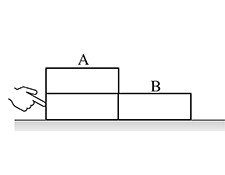
Newton's second and third laws
Variant i Interactive tutorial lecture Other Variants Dynamics first
The tutorial provides practice in identifying forces, constructing free-body diagrams, determining net force, applying Newton's 2nd and 3rd laws, and identifying systems.
Topics Mechanics / Newton's Laws: representations, systems, vectors, acceleration, forces, free-body diagrams, friction, internal vs. external forces, Newton's second and third laws, and vector addition & subtraction
Materials
Materials by the UW team
- Clicker Questions Only


- Instructor Guide


- Pretest



- Pretest for LMS



- Exam Questions



- Equipment List

Tutorial details
Section I: Applying Newton’s laws at constant speed
Students consider three bricks pushed across a table at constant speed. The bricks are split into two systems: one consisting of a single brick and the other consisting of two. After comparing the net force on each system and constructing free-body diagrams, students apply Newton’s second and third laws to rank the magnitudes of all the forces.
Section II: Applying Newton’s laws at varying speed
Students consider a similar scenario, but with non-zero acceleration. They again determine the forces on each system, construct free-body diagrams, and apply Newton’s laws to rank the magnitudes of the forces. In Questions H-J, students construct a free-body diagram and identify internal & external forces for the system of all 3 blocks.
Section III: Interpreting free-body diagrams
Students interpret the free-body diagram for a cart and create a sketch of the physical situation. They then use the forces on the diagram to reason about the possible motions of the cart.
For instruction tips, login or register as a verified educator to see the Instructor Guide.
Prerequisites
This tutorial works best if students have previously been introduced to Newton’s second and third laws in lecture. They should also be familiar with normal, frictional, and gravitational forces.
Research
- L. McDermott, P. Shaffer, and M. Somers, Research as a guide for teaching introductory mechanics: An illustration in the context of the Atwood's machine, Am. J. Phys. 62 (1), 46 (1994).
Coming Soon! We hope to release the discussion section on each tutorial soon.

